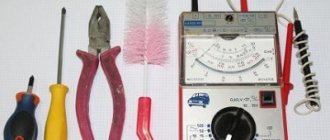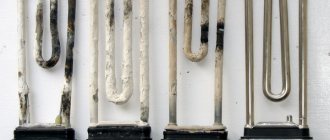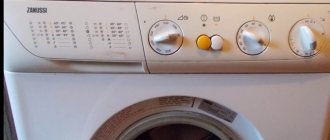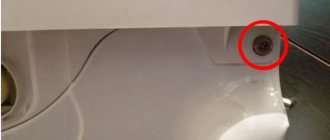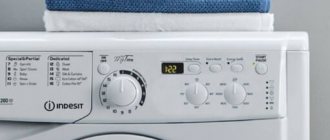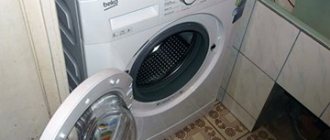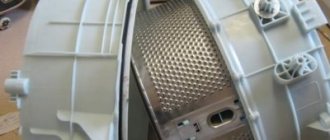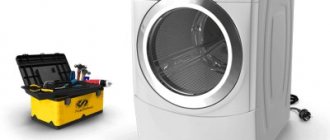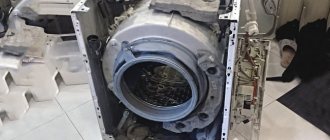The pump in the washing machine is designed to pump water into the drum and drain the waste water through the drain hose into the sewer.
Malfunctions in the operation of the pump are signaled by the control panel, on the display of which the corresponding error code appears. Under this breakdown, different manufacturers encrypt their code, so the same code in machines from different manufacturers can indicate breakdowns of a different nature. If the pump breaks down during the washing process, it will be impossible to drain the water, so the water will remain in the tank, and the hatch will not be able to open, since the control module will signal to continue washing or rinsing. Manufacturers use pumps of different design features and power, depending on the volume of water consumed.
If you are faced with the problem of a pump breakdown, contact our service center, where qualified specialists will diagnose and repair the drain pump, while you will be busy with your own business.
How to understand that the pump is faulty, the reasons for the breakdown?
Before you rush to disassemble the washing machine with your own hands and change the pump, you should accurately determine the cause of the breakdown. It is very possible that the reason is not in the pump at all; this needs to be looked into as thoroughly as possible. Let's proceed as follows.
- First you need to listen to the pump.
- Open and clean the drain filter if necessary.
- Check and clean the drain hose.
- Check the rotation of the pump impeller; it may be jammed.
- Check the sensors and contacts going to the pump.
Some faults can be easily localized by ear without being a specialist, so go to the washing machine while it is running and listen. Wait until the machine begins to drain or fill water, following the program. If the pump hums, tries to work intensively, but water does not flow into the tank or the pump does not make sounds at all, consider that the malfunction is localized.
After you are convinced that the pump is not working as it should, you should determine exactly whether it needs to be replaced or whether you can repair it yourself. First of all, open the drain filter and clean it of debris with your own hands.
If cleaning the filter does not help, check the drain hose for blockages. To do this, the hose must be dismantled and washed with a stream of hot water. Replace the hose and run a test wash. If the pump continues to act up, then you need to look further.
Next, you need to check the rotation of the washing machine drain pump impeller. You can get to the impeller even without disassembling the machine, through the drain filter, which you need to unscrew. To make it more convenient, get a flashlight and shine it into the hole from which you unscrewed the plug.
In the hole you will see the pump impeller. Place your hand in the hole and use your fingers to spin the impeller to see how it works. If the rotation of the impeller is difficult, try to feel for foreign objects that are causing interference (very often these are threads, lint, wire, etc.). If the impeller rotates freely or the cause of the difficult rotation has not been found, you will have to disassemble the washing machine yourself.
Having reached the pump, we check the impeller. If necessary, the drain pump can be dismantled and inspected more thoroughly. If there are no threads and lint, and the impeller still does not spin well, then the reason is in the mechanism and the pump must be disassembled. If the impeller rotates normally, but operates every other time, then the problem is in burnt contacts, a sensor or a control unit.
We select tools and components for repairs
The composition of the necessary tools and components will depend purely on the nature of the problem, so we will describe the option, as they say, to the maximum, if everything is completely bad with the pump. In this case, repairing a washing machine may require the following components:
- drain pump assembly;
- impeller;
- axis;
- cuff;
- pad;
- pulley;
- drain pump sensor;
- contacts.
When purchasing a new pump and parts for it, you should be careful. It is best to take the old unit, take it to a retail outlet that sells similar products, and a sales consultant will help you make a choice. The same should be done with components. Bring the disassembled pump to the store and they will give you the necessary part for it.
With tools the situation is simpler. In most cases, you can remove it with a Phillips screwdriver and a pocket knife. However, if there is a need to check the functionality of electrical equipment (sensors, contacts, wiring), you will need to acquire a multimeter.
How much does a spare part cost, what is the price of a technician?
Repairing a pump is easier and cheaper than replacing it. The cost of repair depends on the prices of the technician and the price of the part being replaced. It can range from 500 to 1000 rubles.
The fact is that having paid for repairs of 1,500-2,000 thousand, in a couple of months you can encounter a breakdown of another part, as a result, the old repaired unit will be more expensive than the new one.
A new Samsung motor, depending on the car model, can cost from 600 to 3000 rubles . The work of a master is about 1000. It should be remembered that the motor is the most worn element of the washing machine. By replacing it, you can safely use the equipment for about 5 more years.
But if the machine has already “demolished” 2 pumps, other components may begin to fail. This means that before replacing the pump again, it is worth conducting a thorough diagnosis of the equipment. It might be cheaper to buy a new car.
Find out more about repairing Samsung washing machines in this section.
Pump repair and replacement
After the part is disconnected, you need to check the washing machine pump. Before disassembling the part, you should inspect the impeller and all holes and make sure that they are not clogged and that there is no hair, thread, wool or other debris wrapped around the blades. You need to pull out the drain filter and inspect the part visually, and then try to turn it. A working unit should turn with pauses due to the coil installed on the magnet. If there is no debris, the impeller rotates with difficulty, and the device will need to be disassembled. To do this you need:
- Remove the pump cover by unscrewing the fasteners or turning it counterclockwise.
- Pry the impeller housing latches to release it.
- If the cross does not give in, you need to heat the shank with a hairdryer and then pry it off with a screwdriver.
- Remove and clean the magnet with impeller.
- Remove the magnet from the shaft and a bearing will appear.
- Apply pump grease to ensure proper bearing function. If it is deformed, install a new element.
- It is also necessary to inspect all rubber gaskets. If they are noticeably damaged, they will need to be replaced with new ones.
- Reassemble the pump in reverse order.
Next you need to ring the pump. Procedure:
- Take a multimeter and set the voltage measurement mode.
- Place the probes on the pump contacts.
- If the screen shows “1” or “0”, the unit is faulty and the pump needs to be replaced.
- If the value consists of several digits, this means that the pump is intact, but the fault is in something else, possibly in the control unit. For accurate diagnosis and subsequent repairs, it is recommended to contact professionals.
If the sump pump needs to be replaced, a new part will need to be purchased. This can be done in a service center, a specialized store or via the Internet. In order not to make a mistake when purchasing, you need to tell the seller the exact make and model of the washing machine or bring the faulty unit. The same should be done with other components that need to be replaced.
Is it difficult to change a part?
You can replace the pump of a Samsung washing machine yourself
It is important to select a replacement element that fully matches the standard one. When the original cannot be found, it is allowed to install an analogue
When choosing a pump, you need to focus on the following characteristics:
- power;
- snail fastening method;
- number of latches or mounting holes for bolts;
- connection method (chip or terminals).
The pump replacement algorithm is as follows:
- disconnect the two power wires going to the pump by removing the terminals;
- unscrew the bolts securing the pump to the volute;
- remove the pump from the housing;
- connect the new pump to its original place in the same position, secure it with self-tapping screws;
- connect terminals, wiring;
- place the SMA in its original position;
- Screw in the garbage filter and close the protective hatch.
Afterwards, you can connect the machine to communications, plug it in and start a test wash. Thus, it is possible to diagnose and replace the drain pump at home, without calling a technician
It is important to strictly follow the rules and instructions for action
Share your opinion - leave a comment
Washing machine pump repair
From life
A breakdown of a washing machine is like “out of the blue.” Everything happens suddenly and rapidly. You arrive home late at night after work. Tired, no strength. Things don’t work out at work with your boss, and with your colleagues too.
Not good. You turn on the TV. A plate under your nose. You try to look at the screen with one eye and... instantly your face ends up in food. You are sleeping and seeing your tenth dream. You wake up and then it starts...
You remember that you forgot to wash your shirt. You scold yourself for being a “bad person.” You quickly put the shirt into the drum of the washing machine, pour in the powder with trembling hands, and leave it for 30 minutes. Bang! The car “stalled” - in the language of avid motorists. Panic, horror, thoughts of a reprimand at work! What to do? How to be?
Real-time repair
The Stirrem.ru company will never leave its clients in trouble, even in the most critical situation. We will promptly help you fix any damage.
Within a short period of time after your call, the technician will arrive on site. Our company’s specialists will perform preliminary diagnostics of the device and carry out repairs.
Below, you can learn more about the function of the pump and find out what it is.
What is a pump?
water pump
in a washing machine this is a very important element. It is a miniature pump, which is located at the very bottom of the device. While the machine is running, all used water goes down the drain. It is the pump that allows you to speed up this process and drain excess water faster. There are two types of pumps:
Nowadays, as a rule, they are no longer installed with an impeller. But they can still be found on older Ariston and Indesit models.
If it so happens that there is water left in the drum during washing, the reason most likely lies in the pump. How to repair a pump
read below...
"Attention! We do not recommend doing self-repairs. It’s better to entrust this matter to professionals.” DIY repair
DIY repair
“Remember ! All of the following is relevant only for a pump with an impeller mechanism.”
What do you need? To be honest, apart from a regular knife and a Phillips screwdriver, nothing. So let's get started right away.
2) Next you will need to remove the back wall of the washing machine. As a rule, all fastenings are held on with ordinary self-tapping screws. After which, having carefully examined the device, we find the pump itself in the lower corner. We disconnect the wires coming from it, unscrew the pump, remove the hoses.
3) After which, you need to disassemble the pump itself. To do this: unscrew the pump volute from the pump body itself. We write down the order in which the engine was installed. Then we carefully remove the engine with the impeller from the snail itself. Let's check if everything is in order. We manually turn the impeller blades; as a rule, they should spin easily (intermittent movements are allowed.)
4) Basically, the breakdown occurs due to the fact that during the use of the washing machine, under the influence of hot water, the casing becomes deformed. Therefore, the impeller blades freely touch it and a breakdown occurs.
"Warning! Don't cut too much. If you remove excess, the pump’s performance will decrease.”
6) Then we put everything back together in reverse order and start the car.
If you succeeded, congratulations. If not, then there is only one option - buying a new pump.
. You can install and purchase a pump from our company at an affordable price. See below for more details...
About us again
Rest assured, using the services of our service center, you can forget about your problems. We work from 9.00 to 21.00, and around the clock. Who said Saturday and Sunday are days off? Taking care of our clients is more important than relaxation. We will create a schedule for the specialist’s arrival individually for you and select the desired day.
We guarantee you quality and reliability. All parts for repairs are purchased from our German partners. Therefore, the part installed in your washing machine can last for many more years.
The company has a transparent pricing policy. And for our regular customers there are various discounts and promotions. Read more
Hurry! Place your order right now and get a discount on 3 services!
Expert advice
Professional technicians who service machines know several causes of breakdowns that do not lie on the surface, but affect the performance of the pump:
- Particularly “bouncy” machines can fray the power supply wires of the pump during washing. Then the pump will appear to be in good working order, but will not work and spin. To diagnose this problem, you will need to disassemble the device down to the electronic control unit. This repair is quite labor intensive. Only a master can handle it; a beginner cannot repair it.
- In some cases, the electronic control unit program may fail. Such diagnostics and repairs can only be performed by a professional technician with special equipment.
- Another rare malfunction is a blockage in the hose running from the main tank to the volute with the pump. It can be determined by hand, squeezing different areas in turn. If necessary, the hose can be removed and cleaned under strong pressure from the tap.
Most often, technicians check the contact group and the pump impeller. If the cause of the breakdown does not concern these parts, the specialist simply replaces the entire assembly.
You can repair the washing machine pump yourself. This is a simple operation, especially if you have an assistant
When working, you need to take precautions, do not forget about the remaining water in the tank and do not try to repair or solder the pump, unless it concerns the impeller or contact group
Washing machines have long become indispensable in everyday life. For smooth operation, you need to install it correctly. Well, if a breakdown occurs, read our articles on how to repair or replace a drum, pump, drain and pressure switch, bearings, heating element, tank.
Restoring the impeller base
Half of the work is completed, now the logical question arises: how to restore the impeller base? If you managed to disassemble the structure correctly, then putting it back together will not be difficult. So, you need to do the following:
- insert the metal shaft into the plastic impeller; to ensure a tight connection, you can press it into the seat with a screwdriver;
- lubricate the rubber gaskets of the structure with lithol;
- attach the shaft with the impeller on it to the rubber part;
- clean the internal cavity of the pump (where the impeller base will be inserted);
- install the structure inside the pump (it will be attracted by a magnet).
- Apply sealant to the cavity in the area of the upper plastic part cut off from the impeller.
This way you can replace the pump impeller. The process happens quite quickly, it will take about one hour to complete the work. The main thing is to prepare all the tools necessary for repairs and imagine what the essence of the upcoming manipulations is.
Cleaning internal contaminants
To do this, use a screwdriver to pry the latch on the motor body on both sides and remove it from the reel.
There are also so-called “non-separable” motors, but they can also be “treated”.
After disconnecting the body with the blades from the coil, we will see a monolithic part. The crosspiece seems impossible to remove. But there is a little trick.
- Take a regular hair dryer, set it to the lowest temperature, put on gloves, and start heating the shank of the part (its long part). Do this with care.
- After a while, when the shank has warmed up well, pry up the crosspiece with a screwdriver and carefully remove it (along with the magnet) from the body.
There may be a lot of dirt on the magnet and in the area from which it was removed. Everything needs to be thoroughly cleaned, after which you can remove the magnet itself from the shaft. You will see a bearing that requires cleaning and lubrication, respectively. Also lubricate the bearing on the bottom of the housing.
Then insert everything into place, with slight pressure until it clicks. The O-ring located under the blades should fit tightly into place.
The figure below shows a dirty motor from an Indesit brand machine.
In motors of this type, in addition to the above procedures, it may be necessary to replace the seals.
Diagnostics
The first stage of diagnosis is to check for signs of incorrect pump operation. Before disassembling the structure, you need to make sure that the malfunction is related to the pump. A breakdown can be identified by the following symptoms:
- the water drainage mode has been activated, but the pumping system is not functioning;
- during the draining process, loud noise and buzzing are heard;
- the pump pumps out water, but more slowly than initially;
- During washing, the machine turns off spontaneously;
- You can hear the hum of the pump motor, but the water does not drain.
If one of the listed breakdowns is present, the pump will most likely need to be repaired. Before proceeding with dismantling and repair, you need to carry out diagnostic steps. To check, remove and clean the drain hose to get rid of the blockage, and then wash the filter. Next, include a test wash in the rinse and drain mode, and if the steps performed did not help eliminate the problem, you should proceed to repair work.
Operating rules
In order for the machine to last as long as possible without repairing or replacing the pump, it is necessary to monitor its operation. At the first sign of a malfunction, stop operation and call a technician. Or deal with the problem yourself.
In addition, you should adhere to the rules for using technology:
Before loading heavily soiled items into the machine, soak and rinse them to prevent large particles from getting into the machine.- Install a filter on the water pipe before entering the machine to prevent rust and other particles found in tap water from getting inside.
- Use high-quality laundry detergents that contain anti-scale agents.
- To rid the pump and other parts of the machine from scale and solid particles, it is recommended to do a “idle” wash at high temperatures once a month using an anti-scale agent instead of powder.
- Do not use a long wash cycle unless necessary.
- After finishing washing, wipe the drum and elastic band dry, and leave the door ajar - this will protect the internal elements from the damaging effects of moisture.
- To prevent small items from getting into the pump, carefully check pockets and folds of clothing before washing.
Diagnostics
Most modern models of Bosch washing machines, for example the Maxx 5-6-7 series, are equipped with a self-diagnosis system, which greatly simplifies the identification of faults. In order to establish the nature of the breakdown, it is not necessary to contact the service center; it is enough to perform a few manipulations, and your machine itself will “tell” what the problem is. So, let's start performing the service test:
- Close the sunroof, move the program selector to the “Off” position.
- Pause for 2-3 seconds, move the switch to “Spin” (clockwise).
- When the Start LED flashes, press and hold the Mode Speed button. Watch "Start" - it should start flashing again.
- Turn the switch to "Drain" (clockwise).
- Release “Revolution Mode” (you didn’t forget to hold this position, did you?).
- Next, put the switch in the position corresponding to testing any component of the washing machine (3 – motor, 4 – drain pump, 5 – tubular electric heater (TEH), 8 – main wash water inlet valve, 14, 15 – quick automatic test). Below is a diagram of the switch and the location of the numbers that correspond to the position of its handle.
Here is a schematic image of the switch and an explanation of the positions of its handle.
Some models differ in the numbering of commands: for example, in the Bosch Logixx 8 washing machine, the motor is checked in the 4th position (by the way, in this washing machine you can carry out quick diagnostics by setting the switch to number 3). When the test is completed, an error code will appear on the display, which the instructions will help you decipher. In older models without a display, the error can be recognized by the glow of the LEDs, after which you can begin to repair the Bosch washing machine.
The photo shows the control panel of the Bosch Logixx 8 washing machine; Diagnostics of breakdowns in it is carried out according to the Bosch Maxx principle, only the numbering of commands is slightly different
It is somewhat more difficult for owners of older generation models - they will have to determine the breakdown based on its symptoms.
Signs of malfunctions and their causes
Devices from earlier years, for example Bosch WFT 2830 or Bosch WFF 1201, cannot independently diagnose problems, so the user will have to do this based on their characteristic symptoms:
- Water is collected slowly or not at all. This occurs due to the accumulation of debris in the inlet filter or a malfunction of the fill valve. The culprit of the breakdown may also be the water level sensor - pressure switch;
- water does not drain well. The problem most often lies in a clogged drain filter, failure of the drain pump or pressure switch;
- the water does not heat up. The heating element is almost always to blame for this. The heating element burns out for two reasons - natural wear or scale formation. Sometimes there is no heating due to problems with the control board or a malfunction of the temperature sensor;
- The drum does not spin. A belt drive transmits torque from the engine to the drum. If the belt falls off or breaks, the drum will not move. A more serious option is engine failure;
- loud noise during spin cycle. The reason usually lies in the destruction of the bearings.
In the photo Bosch Maxx 4 WFC 2060 is a model equipped with a self-diagnosis function
Any of the listed problems can be caused by a failure of the control module (electronic controller). Unfortunately, it is very difficult to repair this unit yourself; it is better not to try. Contact a service that provides repair services for Bosch washing machines at home. Specialists will resolder the board or replace it with a new one.
Symptoms of a problem
If the pump runs continuously for a long time:
- water continues to flow due to a failure of the fill valve, and the machine constantly pumps out excess water in order to prevent the drum from overflowing;
- the drain is poorly pumped (the filter is clogged);
- The electronic control on the washing machine ECU has failed.
The pump gets very hot from long, continuous operation. It turns off due to overheating - the thermal sensor will work. If this does not happen, it hums, which means that one of the components has worn out, such as the impeller or bearings, or one of the windings has shorted. It is possible that it crackles, buzzes or makes noise:
- the water being poured has poor pressure, and it takes in additional effort, noise is observed if the water has recently been turned off, a lot of air has entered the water supply system - its bubbles are currently leaving the water system;
- crackling and “shooting” - the winding has “broken” onto the motor housing or a foreign object has entered the pump;
- humming is a sign of a short-circuited turn in the motor winding.
You must immediately turn off the power and water supply, remove water from the machine, remove the laundry and disassemble the unit. The pump mechanism is often non-separable, but you can first “ring” the motor windings. And also check whether the drainage channels are clogged with debris, dirt or small objects.
Is it difficult to find a pump?
The location of the drain pump is standard in almost all LG models, regardless of whether the machine has a direct drive or a belt drive. Moreover, getting to the location of the malfunction will not be difficult - you will not have to completely disassemble the case. There is also no need to even unscrew the back wall, top cover, tray or front panel. Finding the pump is much easier, since it only requires a series of simple steps.
- Disconnect equipment from electricity.
- Drain waste water from the drum using the emergency drain.
- Shut off the water supply and disconnect from the sewer.
- Tilt the body back, placing old rags under the machine.
All. We look under the bottom and get free access to the entire drain system. There is another way - move the machine to the center of the room and place it on its left side.
When to contact specialists
If you notice signs of a malfunction, it is better not to delay solving the problem and immediately check the equipment for pump failure. Otherwise, there is a risk of worsening the situation, reducing the efficiency of the washing machine and causing additional malfunctions.
If the typical symptoms of a breakdown do not coincide with the existing problem, it is recommended to seek professional help from a service center in order to be sure to get rid of the breakdown and extend the service life of the equipment. Specialists will help you repair or replace the pump, regardless of the model of the washing machine.
How to properly disassemble a washing machine pump
The pump in the washing machine is responsible for pumping water for washing and pumping it out of the tank after the end of the cycle. Usually the water is changed before and after rinsing. But what should you do if water remains in the tank and the machine makes a buzzing noise? Then you need to know how to disassemble and check the washing machine pump.
In the article we will tell you how to remove the pump from the SM housing, disassemble it, clean it and check for serviceability.
Design and types of pumps in a washing machine
The drain pump design is simple. It consists of an impeller, stator and permanent magnet rotor. The rotor can rotate in any direction, so when the impeller is blocked by a foreign object, it can jerk in one direction or the other.
There are two types of pump in washing machines:
- Circulation type pump for supplying water during washing and rinsing. This type of pump is installed on expensive washing machines such as Siemens, Bosch and Hansa.
- Drain sump pump. Pumps waste water out of the tank. The pump also removes water from the tank after spinning. The characteristics of the pump are as follows: power from 20 to 30 W, productivity 20 liters per minute.
Where is the pump located in the washing machine? The exact location depends on the brand of SMA. In Whirlpool, Samsung (Samsung), Ariston, Beko, LG, Indesit models, the pump can be conveniently reached through the bottom, which does not require additional disassembly.
In Electrolux and Zanussi automatic cars, it is enough to remove the rear panel. And in CMA brands AEG, Bosch and Siemens you will have to completely disassemble the front panel.
Signs and causes of malfunction
Before disassembling the water pump, pay attention to the main signs of a problem:
- When filling and draining water, the machine hums and buzzes loudly.
- The washing machine does not respond to installed programs.
- Not enough water is entering the drum.
- There is water left in the drum after washing.
- The drain mode is turned on, but the water drains very slowly.
You must immediately exclude possible causes of the malfunction, such as:
- There is a blockage in the drain filter or hose.
- Problems with electronics. If the contacts going from the control board to the pump are broken, then the pump does not receive a signal to start working.
Also, the reason that the drainage pump does not do its job well could be a jammed impeller. Often, when the impeller rotates, threads or hair get wrapped around it. As a result, it jams and water pumping stops.
What can you do to check?
Checking the drain system is easy. You need to start with the drain filter, which serves as a kind of pump plug. You don't have to disassemble anything to do this. Do this:
- Turn off the water supply tap.
- Prepare a flat container.
- Using a flathead screwdriver, release the latches on the door that closes the drain filter. It is located below the front panel.
- Unscrew the filter, drain the water and inspect it for blockages.
- To check the impeller, shine a flashlight into the filter hole.
- Inspect the impeller to see if there are any foreign objects on it. Also see if it spins when working. If everything is in order, replace the filter.
Preparation for work and disassembly
To repair or replace the water pump, prepare everything you need.
Accessories:
- New pump that fits your washing machine model. Before going to the store, you can remove the old part and show it to the seller. He will suggest a suitable replacement. If you decide to buy components on the Internet, an individual number is indicated on the pump, which you should use to navigate.
- Rubber gaskets.
- Impeller (in case of malfunction).
- Pulley and axle.
- Sensors and contacts for the pump.
Tools:
- Crosshead screwdriver.
- Knife.
- Multimeter.
Pump disassembly instructions
After you have removed the pump for disassembly and inspected the impeller, check the condition of the rubber gaskets. If there is wear on their surface, replace them immediately.
To disassemble, you need to remove the pressure booster pump cover. Do this:
- Let's immediately look at how to remove and install the impeller if it breaks.
- First, the pump volute is removed - you need to unscrew the screws.
- Mark the location of the motor in relation to the volute and remove it along with the impeller.
- Now use a sharp knife to cut off the impeller blades and install everything in the reverse order.
During assembly, you can use a special lubricant for the pump.
To check the pump winding for serviceability, use a multimeter. How to ring the winding? Apply multimeter probes to the winding, measuring the resistance. If the winding is faulty, the part cannot be repaired. Needs a complete replacement.
Did the article help you?
Not really
Principle of operation
When you turn on a certain operating mode of the washing machine, the magnetic valve rises and automatically begins drawing water from the water supply system into the tank under natural pressure.
In this case, water passes through the compartments in which detergents are located, mixing with them. When the water reaches the desired level, the control sensor is triggered, the valve is lowered , and water intake stops.
The pump is connected to the process at the moment when the wash, or its individual stage, ends. It pumps out waste water. Located at the bottom of the machine. This arrangement ensures its operation with minimal energy consumption.
Consists of an electric motor and a plastic working chamber . The pipes are connected to the outside of the chamber. At the end of the chamber there is a filter that collects large particles that get inside the pump.
The pump motor is housed in a plastic housing. The terminals for connecting the power supply are located outside. The working chamber of the pump is always filled with water.
How to choose a drain pump
For more information about the drain pump: where it is located in the washing machine, its operating principle and structure, you can read in this article: what is a water pump for a washing machine
When replacing a drain pump, you must choose a complete analogue in terms of design and technical parameters. All drainage devices differ both in power and performance, and in the method of fastening. You should only choose from proven and reputable manufacturers. Sometimes it happens that the connection of electrical wires to both the drain pump and the circulation pump may have a different location than those that have failed. This nuance usually does not matter and does not affect the installation of the element in its normal place. All replacement operations are carried out in the reverse order of dismantling, with mandatory quality checks of all fasteners and connections.
Where is?
Like most washing machines, all Samsung models have a pump located under the washing chamber .
When dismantling, access is through the bottom or front panel. Dismantling is carried out through the bottom.
To remove and repair the pump, you must have a flathead screwdriver, a Phillips screwdriver, and an open-end wrench. During dismantling, a container is needed to drain remaining water .
Do-it-yourself pump repair
If the drain pump in the washing machine fails due to burnout of the electrical winding, then in this case it is necessary to replace the part. In other cases, it is often possible to restore the device to full functionality, for which you should first clean the impeller and filter. To clean the impeller, you will need to disassemble the device housing. The two halves of the working cavity of this part are usually held together with 3 screws, so it is enough to unscrew the hardware holding the pump parts together to gain access to the impeller.
Disassembling the drainage device
The cause of deterioration in the performance of the drain mechanism, as well as complete jamming of the working shaft, may be threads, hair or long wool. It is necessary to carefully inspect the impeller and shaft and, if such contamination is detected, clean them using a thin screwdriver. The inside of the cochlea also needs to be wiped to remove soap deposits on its walls.
When the parts are cleaned, wash the two halves in water without immersing the engine. Then you need to assemble the housing, connect the pipes and electrical terminals to it and install it in its original place.
When the process of installing the cleaned pump is completed, turn the machine into rinsing mode and check the operation of the drain mechanism. If the device operates in normal mode, then no more
no measures are required; if it was not possible to repair the pump in this way, then it is necessary to replace the electric drain pump in the washing machine.
Symptoms of a problem
If the pump runs continuously for a long time:
- water continues to flow due to a failure of the fill valve, and the machine constantly pumps out excess water in order to prevent the drum from overflowing;
- the drain is poorly pumped (the filter is clogged);
- The electronic control on the washing machine ECU has failed.
The pump gets very hot from long, continuous operation. It turns off due to overheating - the thermal sensor will work. If this does not happen, it hums, which means that one of the components has worn out, such as the impeller or bearings, or one of the windings has shorted. It is possible that it crackles, buzzes or makes noise:
- the water being poured has poor pressure, and it takes in additional effort, noise is observed if the water has recently been turned off, a lot of air has entered the water supply system - its bubbles are currently leaving the water system;
- crackling and “shooting” - the winding has “broken” onto the motor housing or a foreign object has entered the pump;
- humming is a sign of a short-circuited turn in the motor winding.
You must immediately turn off the power and water supply, remove water from the machine, remove the laundry and disassemble the unit. The pump mechanism is often non-separable, but you can first “ring” the motor windings. And also check whether the drainage channels are clogged with debris, dirt or small objects.
